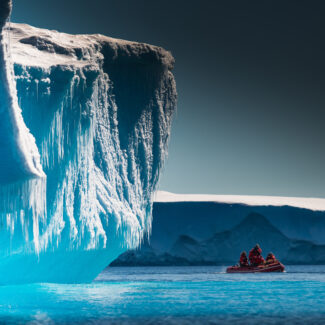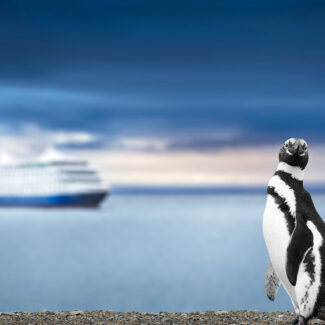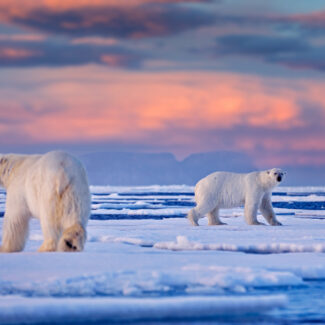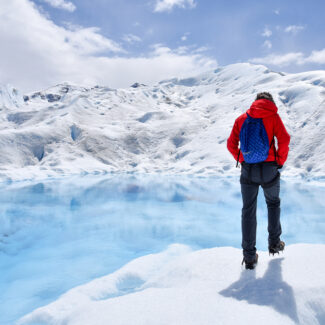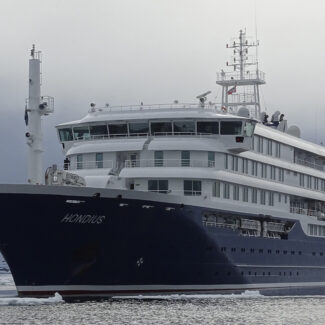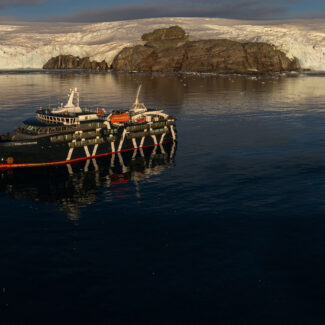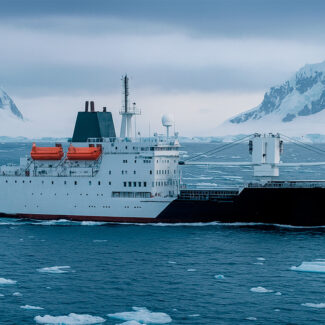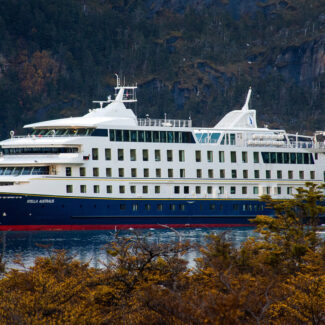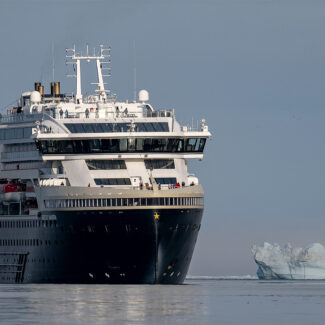Can You Go To The Arctic & North Pole? Yes! Here's How
The Arctic—let alone the North Pole itself, the top of the top of the world—might seem an intimidatingly difficult place to visit. Indeed, it certainly was difficult to reach for most people for most of history, but that’s not the case any longer.
Sure, there are still unbelievably remote and inaccessible places in the Arctic—a stirring and even reassuring thought for many of us—but this gorgeous, austere, ecologically and historically and culturally rich zone can very much be experienced by “everyday” travelers, with luxury and specialty Arctic expedition cruises offering the most comfortable and accessible pathways.
Today, a sightseeing or expedition cruise gives you the Arctic experience via unique and tantalizing blends: R&R and adventure, edification and reflection, shared wonder and private revelation. The opportunity to see glaciers and icebergs up close, to spot dramatic wildlife (from walruses and bowhead whales to polar bears, caribou, and snowy owls), to visit Inuit and other Native communities—and even to take in the dazzling pristine sea-ice panorama from the North Pole itself—explains much of the bucket-list allure of the Arctic for the adventurous traveler, and a cruise is a magical way to explore here.
But can this be done at any time and by anyone? Here we explain all.
When Can You Travel to the Arctic?
The epic expansion and contraction of sea ice in the Arctic Ocean and its edging North Atlantic and North Pacific waters help drive the fundamental rhythm of the Arctic ecosystem. In winter and early spring, the ice pack is at its maximum extent—along with, of course, the extended darkness of the Polar Night and resultant deep chill—which certainly limits ecotourism at the top of the world, with the exception of Northern Lights itineraries taking advantage of the optimal light conditions.
But from late spring into early or mid-fall, extensive areas of open water allow for wide-ranging navigation by cruise ships, and the Arctic summer’s lavish hours of daylight—the season of the Midnight Sun—maximize sightseeing and recreational opportunities. The fact that this time of year, with its surging ecological productivity, also sees an extravagant bloom of biological activity is no small part of what makes Arctic cruises so unforgettable.
Who Can Go to the Arctic?
The boutique and luxury cruise ships we feature put the comfort and well-being of passengers front and center. There are excellent itineraries for most people, but there are a few things to keep in mind.
Age Requirements
For one thing, different cruise operators, vessels, and types of excursions may have minimum age restrictions. Typically for polar cruises there is a minimum age of eight years old. There is no maximum age however, and it’s not uncommon to see octogenarians exploring such high latitudes.
Fitness & Mobility Considerations
Considerations of fitness and physical abilities are not, generally speaking, dealbreakers for our Arctic cruises. We certainly offer a host of exciting and adventurous activities as part of our itineraries, including kayaking and the Zodiac shore-landings that facilitate hiking and other outdoor recreation. But guests who aren’t physically capable of, say, embarking and disembarking from a Zodiac for a shore excursion, trekking on a glacier, or going sea-kayaking among icebergs certainly have much else to savor on an Arctic cruise, enjoying sightseeing, wildlife-watching, and more from the comforts of the cruise ship itself.
Multiple cruise vessels, including Le Commandant Charcot, as well as the Ocean Albatros and others, offer wheelchair accessibility, with wheelchair-accessible cabins, spacious social areas, and elevators connecting passenger decks, but it is important to emphasize that the core expedition activity (Zodiac cruising and shore landings) is often not accessible for guests who rely on a wheelchair or have significant mobility issues.
Ailment Awareness
It is, of course, a good idea for all explorers to convey to a tour operator ahead of time any underlying medical conditions, dietary restrictions, and the like.
Think you’re too seasick-prone to commit to an Arctic cruise? The state-of-the-art stabilizers with which these modern expedition and luxury vessels come equipped hugely reduce rolling sensations aboard, and there are resources available—including seasickness patches and tablets—to help reduce symptoms of nausea.
In short, polar expedition cruises are open to a wide swath of travelers, and there’s no question it’s never been easier, safer, or all-around more comfortable to experience the Arctic.
Where Can You Visit The Arctic?
Arctic cruises can visit a number of different countries and territories, from Russia and Norway (Svalbard) to Iceland, Denmark (Greenland), Canada, and the United States (Alaska). Indeed, some itineraries weave in multiple countries, including non-Arctic ones used as departure points or incorporated into a sail: Some of our Arctic cruise itineraries, for example, also sightsee through Scotland en route to polar waters.
Can You Go to the North Pole?
It surprises many to learn that cruises to the North Pole—yes, the North Pole, that gloriously remote extreme point in the Arctic Ocean set at 90 degrees N and better than 400 miles from the nearest landmass—are possible. That’s right: The answer to “Can you travel to the North Pole on a cruise ship?” is a resounding “Yes!”
The experience comes via the Polar Class 2 Le Commandant Charcot, the first hybrid-electric polar cruise vessel run on liquefied natural gas, and—crucially—an icebreaking cruise ship capable of traveling through multi-year pack ice as much as 8.5 feet thick. On such a remote itinerary—and, indeed, aboard such a luxurious ship—there is a minimum age requirement of eight years old, although such a trip might not be as appreciated by those so young.
Generally on the order of about two weeks to 20 days, North Pole cruises depart from such ports as Longyearbyen, Svalbard—the northernmost town on Earth—and bring you through ethereal Arctic seascapes to give you the chance to stand on the ice at the very top of the world.
North Pole cruises have a narrower window than most of our other Arctic itineraries, with July and August being the only feasible months to reach this farflung spot.
Traveling to the Arctic on a Cruise: Some Logistics & Practicalities
Which travel documents you need depend on your home country, where you’re going, and the duration of your visit.
For example, while Svalbard is part of Norway, unlike mainland Norway it’s not part of the Schengen Area: that open-border geography encompassing 29 countries in Europe. So if you need a visa to visit Schengen countries, you’ll need one to travel from mainland Norway to Svalbard, and will need two entries in your visa, as you’ll be entering and then re-entering the Schengen area in the course of the trip. But visitors from a number of non-Schengen countries, including the United Kingdom, U.S., Canada, Australia, New Zealand, Japan, Mexico, and several others, don’t need a visa to travel in the Schengen Area on trips of 90 days or less.
Check the specific travel requirements for a given Arctic country or territory as they pertain to you based on nationality. Citizens of many countries also don’t need a visa to visit Greenland, including the U.S., Canada, U.K., Australia, and Japan (among others). Canada requires an Electronic Travel Authorization (eTA) of visitors from many countries, including the U.K., Japan, New Zealand, and Australia, but only for those flying into Canada; those entering via cruise ship do not need an eTA.
Keep in mind that many countries require the expiration date of your valid, active passport to be at least six months after the end of your trip.
But is it Safe?
While the Arctic is inherently challenging due to its extreme weather, remote locations, and limited rescue infrastructure, traveling with a reputable expedition cruise operator that adheres to the strict Polar Code and AECO safety standards makes any voyage very safe indeed, as we discuss in greater depth in our article on Arctic dangers covering everything from polar bears to wave conditions.
Travel insurance helps protect you in the event of, say, an emergency medical evacuation, and depending on the type of coverage may also apply to interrupted or canceled trips, lost or damaged baggage, and other inconveniences. Emergency medical evacuation and repatriation with minimum coverage in the hundreds of thousands (US$) is a requirement for Arctic expedition cruises given their remote nature, but amounts differ by operator or itinerary so it is important to check the latest requirements with your polar specialist.
Take the Trip of a Lifetime on an Arctic Expedition Cruise
Luxury and specialist cruise operators make visiting the Arctic safe, straightforward, and well-supported, and provide a surprising amount of creature comforts. Tour operators and expedition staff can help you before and throughout your journey, giving you peace of mind so you can concentrate on the spectacular Arctic environment and its people and wildlife. Explore all of our Arctic cruise itineraries right here!
Disclaimer
Our travel guides are for informational purposes only. While we aim to provide accurate and up-to-date information, Antarctica Cruises makes no representations as to the accuracy or completeness of any information in our guides or found by following any link on this site.
Antarctica Cruises cannot and will not accept responsibility for any omissions or inaccuracies, or for any consequences arising therefrom, including any losses, injuries, or damages resulting from the display or use of this information.



